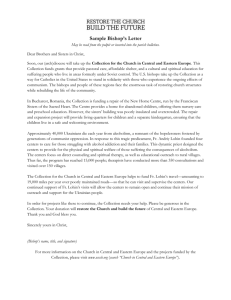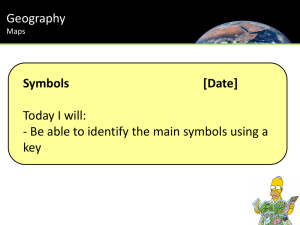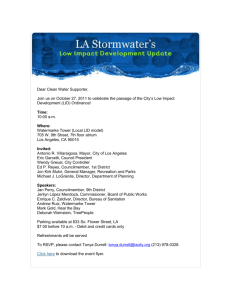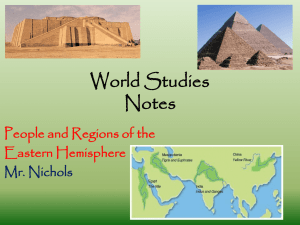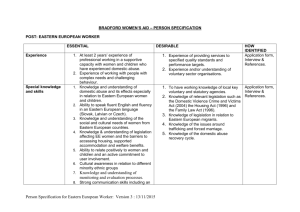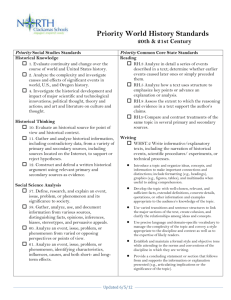Rawie-Unit-Plan - Middle East Studies Center at Portland State
advertisement
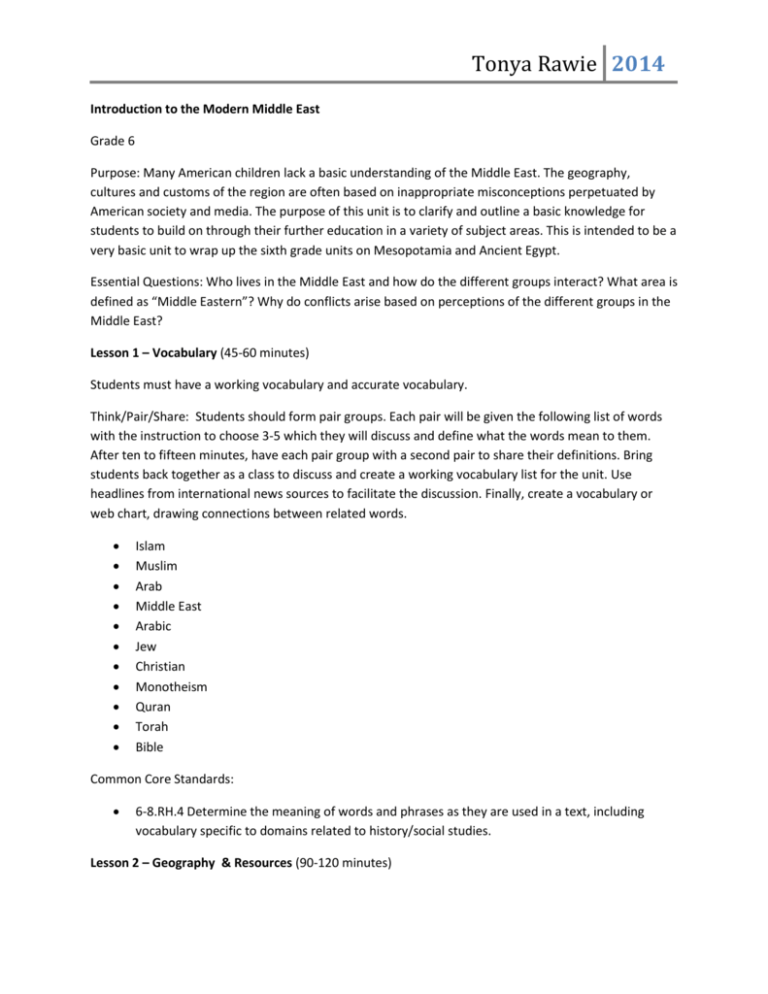
Tonya Rawie 2014 Introduction to the Modern Middle East Grade 6 Purpose: Many American children lack a basic understanding of the Middle East. The geography, cultures and customs of the region are often based on inappropriate misconceptions perpetuated by American society and media. The purpose of this unit is to clarify and outline a basic knowledge for students to build on through their further education in a variety of subject areas. This is intended to be a very basic unit to wrap up the sixth grade units on Mesopotamia and Ancient Egypt. Essential Questions: Who lives in the Middle East and how do the different groups interact? What area is defined as “Middle Eastern”? Why do conflicts arise based on perceptions of the different groups in the Middle East? Lesson 1 – Vocabulary (45-60 minutes) Students must have a working vocabulary and accurate vocabulary. Think/Pair/Share: Students should form pair groups. Each pair will be given the following list of words with the instruction to choose 3-5 which they will discuss and define what the words mean to them. After ten to fifteen minutes, have each pair group with a second pair to share their definitions. Bring students back together as a class to discuss and create a working vocabulary list for the unit. Use headlines from international news sources to facilitate the discussion. Finally, create a vocabulary or web chart, drawing connections between related words. Islam Muslim Arab Middle East Arabic Jew Christian Monotheism Quran Torah Bible Common Core Standards: 6-8.RH.4 Determine the meaning of words and phrases as they are used in a text, including vocabulary specific to domains related to history/social studies. Lesson 2 – Geography & Resources (90-120 minutes) Tonya Rawie 2014 Mapping: Part 1 - Each student will be given a blank outline map of the Middle Eastern region. http://er.jsc.nasa.gov/seh/mission_geography/map_index.pdf Utilizing student atlases, the students will label the nations and surrounding bodies of water of the Middle East. Set the map for a follow up assignment. (20-30 minutes) Part 2 – The teacher will give a short introduction on the term “resources” distinguishing between essential resources and economic resources for the purpose of this lesson. Have students form pair or groups of three. Randomly assign one country to each group. Students are to spend 10-15 minutes gathering information from their student atlas, fact sheets and almanacs, on the resources of their country. Bring students back together as a class. Have each group present the resources of their assigned country. The rest of the class will complete the Middle East Resources grid sheet. Once each group has presented, students are to write similarity/differences notes in the summary notes section of the grid page. If time allows, have students share their summary notes with one or two other students. Common Core Standards: 6-8.RH.7 Integrate visual information (e.g., in charts, graphs, photographs, videos, or maps) with other information in print and digital texts. 6-8.WHST.8 Gather relevant information from multiple print and digital sources, using search terms effectively; assess the credibility and accuracy of each source; and quote or paraphrase the data and conclusions of others while avoiding plagiarism and following a standard format for citation. 6-8.WHST.9 Draw evidence from informational texts to support analysis, reflection, and research. Oregon Social Science Standards: 6.14. Identify physical features of the Western (and Eastern) Hemisphere and explain their effects on people and events. 6.22. Gather, interpret, document, and use information from multiple sources, distinguishing facts from opinions and recognizing points of view. Lesson 3 – Perspectives (90-120 minutes) Today students will explore their perspectives of the Middle East and compare them to Middle Eastern perspectives of the United States. Begin class with a discussion about fact and opinions. Clearlly define the boundaries of a class discussion. Give students 10-15 minutes to answer the following questions: 1. What do you think life is like in the Middle East? 2. How are people who live there like Americans? 3. How are they different from Americans? Tonya Rawie 2014 As students finish, collect and review their answers. Once all students are finished, bring students together for a discussion. Anonomously share a student answer to the first question and facilitate discussion. Repeat for each of the other questions. Interject common perceptions from the PBS Global Connections website. http://www.pbs.org/wgbh/globalconnections/mideast/questions/types/index.html#arab_muslim At the appropriate point, have students answer the initial three questions again. Common Core Standards: 6-8.RH.8 Distinguish among fact, opinion, and reasoned judgment in a text. Oregon Social Science Standards: 6.22. Gather, interpret, document, and use information from multiple sources, distinguishing facts from opinions and recognizing points of view. 7.18. Investigate current issues in the Eastern Hemisphere and how they relate to other countries, including the United States. Unit Assessment: Students should prepare a mini-portfolio of their work consisting of the following assignments. (30 minutes) Vocabulary Web Chart Map Middle East Resources Grid Perspective pre-lesson answers Perspective post-lesson answers Self assessment. Have students write no more than one page about something they learned during this unit.



